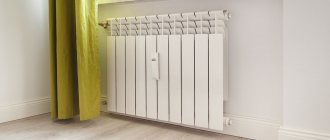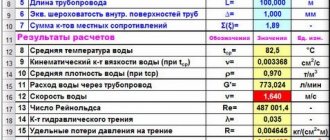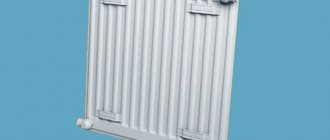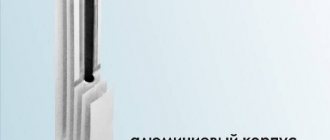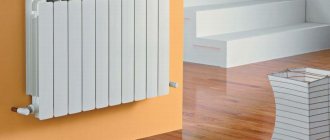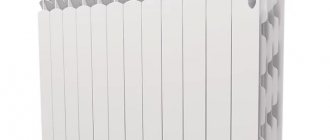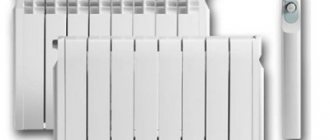Calculation by area
This is the simplest option for determining a more or less exact amount of heat required for heating. When calculating, the main starting point is the area of the apartment or house where heating is organized.
The area of each room is available in the apartment plan, and to calculate specific values for heat consumption, SNiP comes to the rescue:
- For the average climate zone, the norm for a residential premises is defined as 70-100 W/1 m2.
- If the temperature in the region drops below -60 degrees, the heating level of each 1 m2 must be increased to 150-220 W.
To calculate panel heating radiators by area, in addition to the given standards, you can use a calculator. The power of each heating device must be taken into account. It is better not to allow significant overexpenditures, because... As the resulting power increases, the number of batteries in the system also increases. In the case of central heating, such situations are not critical: there, each family pays only a fixed cost.
It’s a completely different matter in autonomous heating systems, where the consequence of any overconsumption is an increase in payment for the volume of coolant and the operation of the circuit. It is impractical to spend extra money, because... Over the course of a full heating season, a decent amount can accrue. By using a calculator to determine exactly how much heat is needed for each room, it is easy to find out how many sections to purchase.
For simplicity, each heating device indicates the amount of heat it produces. These parameters are usually contained in the accompanying documentation. The arithmetic here is simple: after determining the amount of heat, the resulting figure must be divided by the battery power. The result obtained after these simple operations is the number of sections required to replenish heat leaks in winter.
For clarity, it is better to look at a simple example: let’s say that you need only 1600 Watts, with the area of each section being 170 Watts. Further actions: the total value of 1600 is divided by 170. It turns out that you need to purchase 9.5 sections. Rounding can be done in any direction, at the discretion of the home owner. If there are additional heat sources in the room (for example, a stove), then you need to round down.
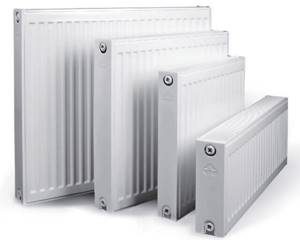
The opposite direction is calculated if the room has balconies or spacious windows. The same applies to corner rooms, or if the walls are poorly insulated. The calculation is very simple: the main thing is not to forget about the height of the ceilings, because... it is not always standard. The type of building material used to construct the building and the type of window blocks also matter. Therefore, the data for calculating the power of steel heating radiators should be taken as approximate. The calculator is much more convenient in this regard, because... it provides for adjustments to building materials and premises characteristics.
Specifications
For steel panel radiators, the main parameters are: pressure, heat transfer (thermal power) and operating temperature.
- Operating pressure. The products operate in two main pressure ranges.
- From 7 to 8 bar, which is typical for heating systems in European countries. This norm is due to the fact that the main buildings are of the low- and mid-rise type.
- 10 bar. This indicator is used in most heating systems in the CIS countries (in particular in Russia). A low-rise building (up to 5 floors) is characterized by a pressure of 4 bar, for a typical nine-story building - from 5 to 7 bar, in taller buildings (above 14 floors) the pressure reaches 10 bar.
- Maximum operating temperature. The standard for products of this class of radiators is a temperature of 110 degrees. Due to this indicator, they are not used in steam systems.
- Heat dissipation. This is the main characteristic for any radiator - the efficiency of heat transfer from water through metal to the room depends on it. This parameter is measured in watts and shows the amount of thermal energy transferred to the environment per unit of time. Heat transfer is determined by the characteristics of the fins, the standard size of the panel and the thermal operation mode of the heating system (water temperature).
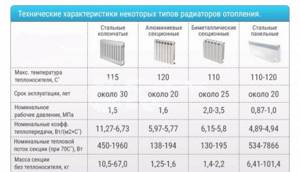
According to the EN442 standard, the thermal mode must have parameters 75/65/20, where the first digit is the temperature of the incoming water, the second is the outgoing water, and the third is the air in the room.
In a mode different from this, determining the thermal power of a steel panel radiator will require recalculation. For its accuracy, a factory specification for products, correction factors and a conversion formula are required.
The main rule: the smaller the mode parameters, the more powerful the radiators are needed to ensure the same room temperature.

How to adjust preliminary indicators
Approximate values definitely need clarification. To obtain a more accurate result, you will need to take into account all factors.
Each of them can provoke an increase or decrease in heat loss:
- Material for walls.
- Thermal insulation efficiency.
- Area of window units and type of glazing.
- Number of external walls.
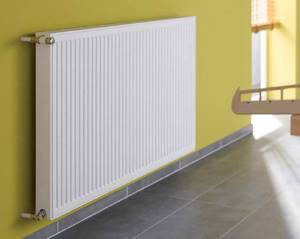
High-quality calculators are equipped with special coefficients that take these factors into account. All that is required to more accurately align the preliminary heat loss indicators is to multiply them by these coefficients.
Selection and operation: tips and nuances
When selecting radiators for certain conditions, it is worth considering some features of steel panel radiators.
- For low- and mid-rise buildings, you should use radiators designed for an operating pressure of 8 bar - this safety margin will ensure long-term operation without breakdowns.
- To make a side connection, you need to unscrew the thermostatic insert. The fastening must be reliable.
- A prerequisite for effective heating with steel radiators is air circulation; therefore, it is not recommended to place the products too close to the floor and window sill.
- It is better not to remove the original packaging until installation is complete - this way the coating will be better protected from damage.
- If a single-pipe heating system is used, then it is necessary to add valves with increased flow capacity.
- When choosing radiators, one should take into account not the width of the window sill openings, but the required amount of heat and the corresponding heat transfer of the products.
The following video will tell you more about steel panel radiators.
Window
Most often, it is these structural elements that become the culprits of leakage from 14 to 30% of heat. For a more accurate calculation, you need to take into account their size and level of insulation. This explains the presence of two calculated coefficients.
Ratio of window area to floor area:
- 10% — 0,8
- 20% — 0,9
- 30% — 1,0
- 40% — 1,1
- 50% — 1.2
The last number is the coefficient.
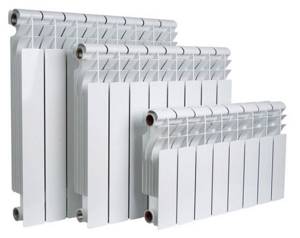
Type of double glazed windows:
- Three-chamber - 0.85.
- Double-chamber - 1.0.
- Wooden double frames - 1.27 or 1.3.
When considering walls and roofing, the type of material and insulation is taken into account: therefore, there are also two coefficients.
Insulation:
- A brick wall of normal thickness is used as a basis. The coefficient is equal to one.
- For small thicknesses, the coefficient is taken as 1.27.
- Well-insulated structures with a thermal insulation thickness of at least 10 cm: correction number 0.8.
Advantages and disadvantages
Steel panel radiators have a large number of different features, among which are some positive qualities:
- moderate cost allows you to select radiators with high thermal efficiency even with a modest budget;
- good heat transfer;
- a wide selection of panel types and sizes allows you to select radiators of the required dimensions, precisely suited to the specifics of the room;
- a variety of connection options contributes to convenient operation of the product with unusual room contours;
- can be used in low-temperature heating systems due to the high heat transfer provided by the fins;
- Comfortable thermoregulation is ensured by low thermal inertia.
Also, steel radiators have their disadvantages:
- poor resistance to corrosion, which is weakened by the presence of oxygen in water (the worst period of time is emptying the system, when the strength of corrosion processes is maximum);
- devices deteriorate if there is dirt in the water;
- poor resistance to hydraulic shocks;
- low maximum operating pressure (up to 10 bar);
- Due to the dominance of convective heat transfer in steel radiators, there must be good air circulation in the room.
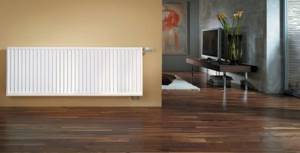
How are steel radiators calculated?
Panel-type steel batteries are considered a novelty in the field of heating household appliances. Their feature is their more compact dimensions. The heat transfer of steel radiators is an order of magnitude higher compared to conventional sectional radiators with batteries. The structure may include several corrugated metal panels (1,2 or 3 pieces). Panels refer to the plates through which coolant enters the system. Before you calculate panel radiators by power, you need to arm yourself with information about the main types of these devices.
Data from the power table of steel heating radiators:
- Three-panel. The massiveness of the devices is explained by the presence of 3 panels equipped with fins. Marked 33.
- Double panel. The number of plates has been reduced to two. Marking - 22.
- Double panel plus one plate (21).
- Single panel with one plate. They are characterized by low power, light weight and compact dimensions (11).
- Only panel without fins (10).
The power of such devices is also calculated by area, but they are based not on a square meter, but on a cubic meter.
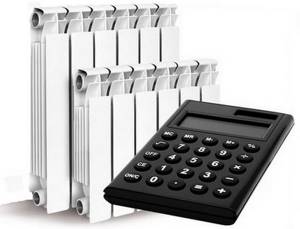
SNiP requirements:
- In brick houses, 34 watts are required per 1 m3.
- In panel buildings, 41 watts are required per 1 m3.
Keeping these standards in mind, you can calculate any room. Knowing the height of the ceilings is a must.
Calculation example:
The panel building has dimensions of 3.2 by 3.5 meters, with a ceiling height of 3 m. To determine the volume, you need to multiply 3.2, 3.5 and 3: the result is 33.6 m3. This figure is multiplied by the coefficient for a panel house (41). The result is 1378 W. To obtain the most accurate value, use a calculation table for steel heating radiators. It displays information on each climate zone and object characteristics.
Features of application
Based on the design features and technical characteristics, a certain scope of application of steel panel radiators is formed.
The following points are characteristic:
- radiators are recommended for use in closed heating systems of private houses and new buildings, heated by means of heating points and individual wall-mounted boilers;
- steel radiators are not recommended for use in apartment buildings with a central heating system and in private houses with a gravity system;
- The optimal conditions for steel radiators are heating systems with low temperature modes, which use condensing boilers (the optimal mode is characterized by an outlet water temperature of 50-55 degrees).
Steel panel radiators are classified according to various criteria: by the presence of convective fins, by connection option, by the design of the front panel. In addition, there are different standard sizes of panels.
Based on the presence of convective fins, two main types are distinguished:
- with convective fins;
- hygienic panels without ribs, the distinctive feature of which is easy access to the inside of the product for cleaning; they are also not equipped with decorative grilles, and the devices are used in rooms with increased requirements for hygienic standards.
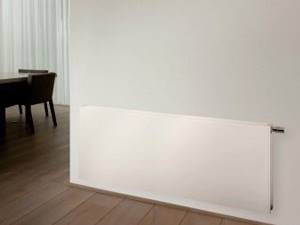
Steel panel radiators are also divided into groups depending on the connection option.
- Lateral connection.
- Bottom connection. This product is equipped with two additional pipes (3/4 HP or 1/2 HP), has a center-to-center distance of 5 cm and a built-in thermostatic valve insert. In this case, the thermostatic head must be purchased separately. The connection pipes are located on the panel at the bottom right. There is also a version with a central bottom connection, the pipes of which are located on the lower left. This single-panel option is quite popular.
Percentage increase in power
You can take into account heat loss not only through walls, but also through windows.
For example, before choosing a steel heating radiator, the area calculation must be increased by a certain percentage depending on the number of windows in the room:
- If there are two external walls and one window, the indicator increases by 20%.
- If there are two windows and walls facing the outside, then 30% is added.
- When the walls are internal, but the window faces north, then by 10%.
- If the apartment is located inside the house and the heaters are covered with grilles, then the heat output of steel panel radiators should be increased by 15%.
Taking into account such nuances before installing steel panel batteries allows you to choose the right model correctly. This will save money on its operation with maximum heat transfer.
Therefore, you should not only think about how to select steel heating radiators based on the area of the room, but also take into account its heat loss and even the location of the windows. This integrated approach allows you to take into account all the factors affecting the temperature in an apartment or house.
netholodu.com
Summarizing
The principle is better to underfill than the opposite; it is not applicable in heating systems, since airing the system will mean cold radiators. By calculating the volume of each structural element of the heating system using tables or empirically, heat consumption will become more meaningful and enjoyable. And repairing or replacing a separate fragment will no longer be a sealed secret.
The video in this article shows the process of pouring coolant into the heating system.
Did you like the article? Subscribe to our Yandex.Zen channel
